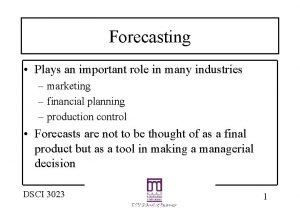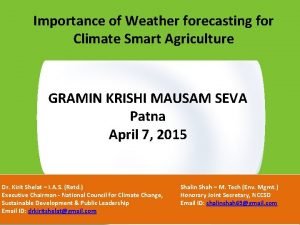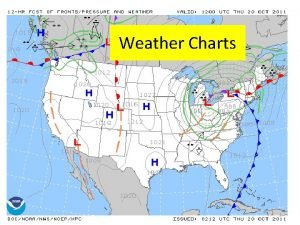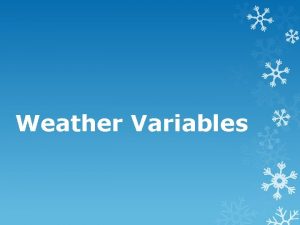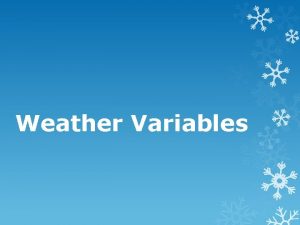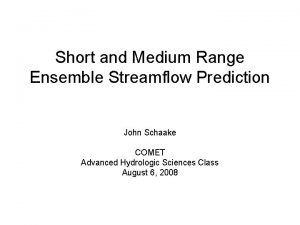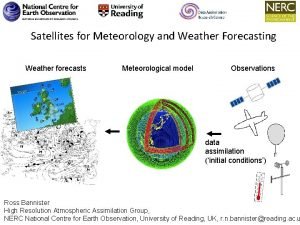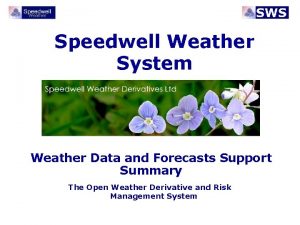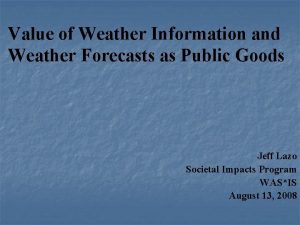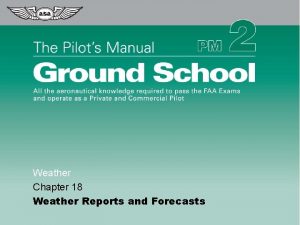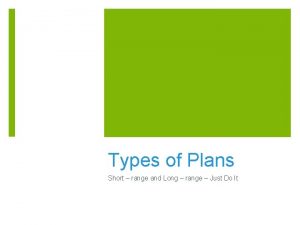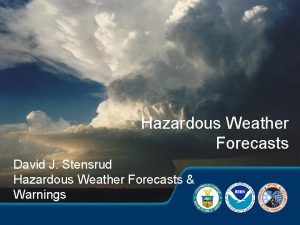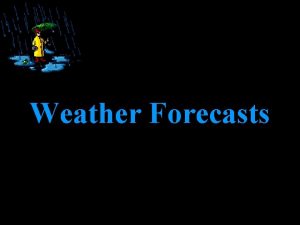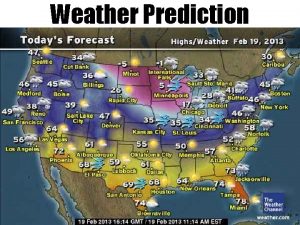Short and medium range weather forecasts for agriculture






































- Slides: 38

Short and medium range weather forecasts for agriculture based on the post-processing of the ECMWF-EPS outputs Antonio Mestre Instituto Nacional de Meteorología Spain WMO/Cost 718 Expert meeting on weather, Climate and Farmers, 15 -18

Summary of the presentation n n Introduction: Weather forecasts requirements from the agricultural sector. Quantitative probabilistic weather forecasts in agrometeorology as a tool for decision-making purposes. The probabilistic approach in weather forecasting : The Ensemble Prediction concept. Weather forecasts tailored to the users from the agrarian sector produced by postprocessing of the ECMWF-EPS in Spain. Conclusions WMO/Cost 718 Expert meeting on weather, Climate and Farmers, 15 -18

Weather forecasting as a tool for decision making purposes in agrometeorology. The availability of weather forecasts it is a key component in short-term decisions in agriculture: n a) whether to carry out or not specific agricultural practices n b) in irrigation schemes based on the accurate evaluation of the water requirements to counterbalance crop’s hydric needs WMO/Cost 718 Expert meeting on weather, Climate and Farmers, 15 -18

Weather forecasting as a tool for decision making purposes in agrometeorology. n c) in the switch on of protection systems against potentially risky phenomena. n d) to assess the required level of intervention in the possible occurrence of forest fires, to estimate the degree of potential danger of forest areas at risk of ignition and to establish the operational planning once the forest fire has started. WMO/Cost 718 Expert meeting on weather, Climate and Farmers, 15 -18

Agricultural users: general requirements of weather forecasts n There is a need to have access to quantitative local forecasts of the most important variables, such as extreme temperatures, probability of precipitation occurrence, as well as its estimated amount, wind’s speed and direction, and relative humidity. n To make use of early warning systems for the possible ocurrence of especially adverse meteorological conditions which could constitute crops limiting factors, such as frosts, strong winds, hail or severe precipitations, conditions favourable for pest and disease rising and spreading, , drought early warning…. . the availability of reliable forecasts of these events is required. WMO/Cost 718 Expert meeting on weather, Climate and Farmers, 15 -18

Agricultural users: general requirements of weather forecasts n The probabilistic approach in local weather forecasting presents sensible advantages for users in their decisionmaking strategy, making possible the selection of different probability thresholds for different specific interventions, depending on the user’s own needs. WMO/Cost 718 Expert meeting on weather, Climate and Farmers, 15 -18

The probabilistic approach in weather forecasting : The Ensemble Prediction concept (1). n In the “Ensemble Prediction System” an ensemble of integrations are simultaneously run every day, starting from a set of slightly different initial conditions created around the estimated most probable initial state, in such a way that, running this ensemble of integrations, the set of atmospheric scenarios for a specific moment in the future (starting from an initial state) could be simulated in the best possible way. n The Ensemble Prediction System outputs are a set of values as large as the number of the set of members for each parameter, specific location and specific time range. Consequently, we have an estimate of the temporary evolution of the probability density function for the different meteorological variables of interest. WMO/Cost 718 Expert meeting on weather, Climate and Farmers, 15 -18

The probabilistic approach in weather forecasting : The Ensemble Prediction concept (1). n The EPS outputs could constitute the base for the generation of a wide range of probabilistic products useful in agrometeorology, such as for example: “local frost probability” or “probability of accumulated precipitation in a specific location and period amounting more than 5 mm”, maximum gust wind speed of more than 80 Kms/h…. . . WMO/Cost 718 Expert meeting on weather, Climate and Farmers, 15 -18

The probabilistic approach in weather forecasting : The Ensemble Prediction concept (2). n The EPS provides forecasts in a way that enables the user to adopt the most adequate decision, and thus to optimise the ratio between the cost associated with the adopted preventive decision and that of the avoided damage (C/L). n The economic value of the raw outputs of the EPS system in binary decision situations making use of cost/loss analysis has been clearly stated and is routinely assessed. WMO/Cost 718 Expert meeting on weather, Climate and Farmers, 15 -18

The probabilistic approach in weather forecasting : The Ensemble Prediction concept (3). n On the other hand the value of the “end to end” forecasting of variables that have a weather dependent component using the ECMWF-EPS outputs has been also assessed in a decision making scenario in which both the outcome and the decision are continuous variables (Smith L. A, Roulston M. and von Hardenberg J. , 2001). n These results show the potential interest of the EPS in agrometeorology. n The EPS outputs could be directly used as inputs in agrometeorological probabilistic models or be the base of more refined end-user products get frorn statistical post-processing. WMO/Cost 718 Expert meeting on weather, Climate and Farmers, 15 -18

The probabilistic approach in weather forecasting : The Ensemble Prediction concept (5). WMO/Cost 718 Expert meeting on weather, Climate and Farmers, 15 -18

The probabilistic approach in weather forecasting : The Ensemble Prediction concept (6). WMO/Cost 718 Expert meeting on weather, Climate and Farmers, 15 -18

Medium-term weather forecasts for agriculture get from EPS by statistical postprocessing (1). n To produce reliable probabilistic or deterministic forecasts of meteorological parameters in surface of interest in agrometeorology from numerical weather model outputs, it is common to apply a statistically based post-processing before the production of the end-user forecasting product WMO/Cost 718 Expert meeting on weather, Climate and Farmers, 15 -18

Medium-term weather forecasts for agriculture get from EPS by statistical postprocessing (1). n The need of this post-processing is more evident in the case of parameters with a very high spatial and temporal variability as it is case of the precipitation, or very correlated with topographic features as the temperature. In the case of precipitation, among the different postprocessing tools used it could be quoted the following: MOS; neural networks (D. Silverman y D. Dracup, 2000), multiregression schemes, discriminant analysis, use of Kalman filters and the models based in the analogies (Boren, Ribalaygua y Balairón, 1995). WMO/Cost 718 Expert meeting on weather, Climate and Farmers, 15 -18

Medium-term weather forecasts for agriculture get from EPS by statistical postprocessing (2). n A project aimed at the development of new local quantitative deterministic and probabilistic meteorological forecasts for end users from different productive sectors, in particular the agricultural one, has been recently launched in Spain by the INM. WMO/Cost 718 Expert meeting on weather, Climate and Farmers, 15 -18

Medium-term weather forecasts for agriculture get from EPS by statistical postprocessing (2). The products are mainly based in the post-processing of ECMWF-EPS outputs, including local deterministic and probabilistic forecasts for different parameters, namely: n n n Precipitation. Daily extreme temperatures. Total cloud cover. Wind speed and direction. UV Relative humidity and global radiation (in progress). WMO/Cost 718 Expert meeting on weather, Climate and Farmers, 15 -18

Medium-term precipitation forecasts for agriculture get from EPS by statistical postprocessing. n Local and areal quantitative probabilistic precipitation up to seven days in advance produced and are available trough the (Fernández A. and others, 2001). n A technique of calibration of the EPS precipitation outputs based on an analogical approach is utilised. The method of “analogues” chooses the 30 days most similar to the case your are dealing with, out of a reference dataset, for each synop station and grid point. Once the set of “analogues” has been selected, the probability of any specific event is obtained as the relative frequency of such event over the analogues sub-sample. WMO/Cost 718 Expert meeting on weather, Climate and Farmers, 15 -18 forecasts of daily are now routinely INM web page

Medium-term precipitation forecasts for agriculture get from EPS by statistical postprocessing. n The analogical approach is used for the post-processing of the outputs of the Ensemble Prediction System. For each of the 51 members of the Ensemble Prediction System, the analogues are obtained from the reference dataset of cases for each different forecast range up to D+7). WMO/Cost 718 Expert meeting on weather, Climate and Farmers, 15 -18

Medium-term precipitation forecasts for agriculture get from EPS by statistical postprocessing (2). n The probability that the daily precipitation (from 07 UTC to 07 UTC) exceeds a specific threshold is obtained for a total of 88 different stations and for the 203 gridpoints. n Based on the analogues gridded outputs and using a multi -regression scheme the precipitation prediction system has recently been extended to producing local probabilistic rainfall forecasts for every Spanish town or village up to a total of 8000 locations. This information is partly available in the INM web page. WMO/Cost 718 Expert meeting on weather, Climate and Farmers, 15 -18

Medium-term precipitation forecasts for agriculture get from EPS by statistical postprocessing (2). n On the other hand probabilistic forecasts of total amount of precipitation accumulated in a certain period of time exceeding a predefined threshold are also available. WMO/Cost 718 Expert meeting on weather, Climate and Farmers, 15 -18

Medium-term precipitation forecasts for agriculture get from EPS by statistical postprocessing (3). WMO/Cost 718 Expert meeting on weather, Climate and Farmers, 15 -18

Medium-term precipitation forecasts for agriculture get from EPS by statistical postprocessing (4). WMO/Cost 718 Expert meeting on weather, Climate and Farmers, 15 -18

Comparative verification of local probabilistic forecasts of precipitation exceeding 0, 5 mm in 24 hours for D+3 from direct model outputs of the EPS model (red line) and from EPS outputs postprocessed by the technique of analogues (blue line). WMO/Cost 718 Expert meeting on weather, Climate and Farmers, 15 -18

Economical value of local probabilistic forecasts of precipitation exceeding 0, 5 mm in 24 hours for D+1 and D+2 WMO/Cost 718 Expert meeting on weather, Climate and Farmers, 15 -18

Economical value of local probabilistic forecasts of precipitation exceeding 10 mm in 24 hours for D+1 and D+2 WMO/Cost 718 Expert meeting on weather, Climate and Farmers, 15 -18

Example of probabilistic forecasts of weekly precipitation MODELO EPS-INM PRECIPITACION ACUMULADA A 7 DIAS EN ls/m 2 PREVISTAS DESDE EL 10 -11 -04 HASTA EL 16 -11 -04 PROBABILIDAD EN % DE PRECIPITACION POR ENCIMA DE LOS UMBRALES INDICADOS CAPITALES DE PROVINCIA Y CIUDADES GALICIA LA CORUNA PONTEVEDRA ORENSE LUGO UMBRALES en ls/m 2 1 10 20 30 40 60 100 40 12 6 4 0 94 12 8 4 0 0 81 10 8 4 0 0 100 75 39 12 8 4 WMO/Cost 718 Expert meeting on weather, Climate and Farmers, 15 -18

Medium-term temperature forecasts for agriculture get from EPS by statistical postprocessing (1). n Local objective forecasts of 2 m-Temperature are obtained from EPS-outputs, including deterministic forecasts, probabilistic forecast and maps. n Local deterministic forecasts up to D+10 of maximum and minimum temperatures as well as spot temperature every 6 hours for more than 350 SYNOP stations over Spain are obtained by filtering of the 2 m-temperature ensemble mean. An on-line objective verification system of these temperature forecasts has been developed in order to produce verification reports that are issued on a monthly base. WMO/Cost 718 Expert meeting on weather, Climate and Farmers, 15 -18

Medium-term temperature forecasts for agriculture get from EPS by statistical postprocessing (1). n Local probabilistic forecasts up to ten days in advance that daily extreme temperatures exceed a set of predefined thresholds are also obtained by statistical post-processing of 2 mtemperature EPS members. n Using these local forecasts temperature grid is routinely with 0. 025º resolution. and a DEM a built every day WMO/Cost 718 Expert meeting on weather, Climate and Farmers, 15 -18

Medium-term temperature forecasts for agriculture get from EPS by statistical postprocessing (2). n For each observatory a ‘local simple regression of the temperature with the altitude’ allows to obtain its lapse rate. The final temperature grid is obtained from Metview via an algorithm that works with the temperatures and lapse rates at the observatories and the DEM. This method is applied directly to the forecasted (D+1 to D+10) extreme temperatures at the observatories. n Derived products of these grids are maps and interpolated temperatures for a total of around 8000 locations that are also available in INM web page. WMO/Cost 718 Expert meeting on weather, Climate and Farmers, 15 -18

Medium-term temperature forecasts for agriculture get from EPS by statistical postprocessing (3). WMO/Cost 718 Expert meeting on weather, Climate and Farmers, 15 -18

Medium-term temperature forecasts for agriculture get from EPS by statistical postprocessing (4). WMO/Cost 718 Expert meeting on weather, Climate and Farmers, 15 -18

Medium-term temperature forecasts for agriculture get from EPS by statistical postprocessing (5). WMO/Cost 718 Expert meeting on weather, Climate and Farmers, 15 -18

Medium-term temperature forecasts for agriculture get from EPS by statistical postprocessing (6). Example of probabilistic forecast (Tmín <0ºC) 09 10 11 12 13 14 15 16 17 Mart Mier Juev Vier Saba Domi Lune Mart Mier ---------------------------------------------------MADRID /RETIRO. . 0 0 0 4 4 6 MADRID /C. UNIVERSITARIA. . 0 0 2 2 4 4 8 MADRID /BARAJAS. . 0 0 2 2 8 8 14 MADRID /CUATRO VIENTOS. . . 0 0 2 2 4 8 14 MADRID /GETAFE. . 0 0 2 2 4 6 12 MADRID /TORREJON. 0 0 6 10 4 24 27 BUITRAGO 2 2. 27 27 27 18 33 41 49 ROBLEDO DE CHAVELA. . . 0 0 0 2 10 12 14 NAVACERRADA /PUERTO 92 53 96 86 80 88 86 96 100 ALTO DE LOS LEONES 0 37 53 55 57 69 71 82 78 COLMENAR VIEJO /FAMET. 0 0 4 10 6 25 31 ARANJUEZ. . 0 0 4 10 4 24 25 MADRID 08222 08220 08221 08223 08224 08227 08146 08212 08215 08217 08219 08229 WMO/Cost 718 Expert meeting on weather, Climate and Farmers, 15 -18

Medium-term forecasts for agriculture get from EPS by statistical post-processing (other variables). n Local forecasts for other meteorological variables as total cloud cover, wind speed and direction and UV are also currently produced by the system by post-processing of both EPS and deterministic ECMWF models. n Cloudiness and wind: probabilistic multi-categorical forecasts up to D+10 of total cloud cover and wind in five categories as well as determinstic forecasts from EPS mean. WMO/Cost 718 Expert meeting on weather, Climate and Farmers, 15 -18

Medium-term forecasts for agriculture get from EPS by statistical post-processing (other variables). n UV-B máx index is also predict up to D+3. n An application producing pictograms that integrate all this information for the different parameters for every Spanish town and village and put it in the external INM web page has recently been carried out, so this information is now freely available. WMO/Cost 718 Expert meeting on weather, Climate and Farmers, 15 -18

WMO/Cost 718 Expert meeting on weather, Climate and Farmers, 15 -18

Discussion (1) n The users coming from the agrarian sectors require more and more meteorological inputs for decision-making purposes. In particular the disposition of quantitative local forecasts of the relevant meteorological parameters is vital for many applications in agrometeorology. n The gain in spatial and time resolution of the numerical weather models and the improvements in its physic allows to have more and more high quality forecasts to be used in an operational context. WMO/Cost 718 Expert meeting on weather, Climate and Farmers, 15 -18

Discussion (2) n The development of new prediction products for farmers based on the post-processing of weather model outputs (both deterministic and probabilistic) in the short and medium range is now of particular importance in agrometeorology, to this respect special attention deserve to be paid to the consideration of the best possible way to disseminate this information to all the potential end-users. n On the other hand the data from weather models could be also used as virtual observations direct inputs in agrometeorological models as a way to face up to some of the problems derived from the use of local meteorological observations. WMO/Cost 718 Expert meeting on weather, Climate and Farmers, 15 -18
 As compared to long-range forecasts, short-range forecasts
As compared to long-range forecasts, short-range forecasts Tall+short h
Tall+short h Lesson outline lesson 3 weather forecasts answer key
Lesson outline lesson 3 weather forecasts answer key Compare and contrast analog and digital forecasts
Compare and contrast analog and digital forecasts What is cold media
What is cold media Vydj
Vydj Forecasting plays an important role in
Forecasting plays an important role in Contingent crop planning slideshare
Contingent crop planning slideshare Medium voltage range
Medium voltage range Short, medium and long term planning in education
Short, medium and long term planning in education Long term goals examples
Long term goals examples He's medium height
He's medium height Weather symbols for station models
Weather symbols for station models Tongue twisters whether the weather
Tongue twisters whether the weather Weather and clothes
Weather and clothes Its stormy
Its stormy Whether the weather is fine or whether the weather is not
Whether the weather is fine or whether the weather is not Heavy weather by weather report
Heavy weather by weather report Capital weather gang weather wall
Capital weather gang weather wall Surface analysis chart symbols
Surface analysis chart symbols Short range communication
Short range communication Long range reference service in library
Long range reference service in library Kontinuitetshantering
Kontinuitetshantering Novell typiska drag
Novell typiska drag Nationell inriktning för artificiell intelligens
Nationell inriktning för artificiell intelligens Vad står k.r.å.k.a.n för
Vad står k.r.å.k.a.n för Varför kallas perioden 1918-1939 för mellankrigstiden?
Varför kallas perioden 1918-1939 för mellankrigstiden? En lathund för arbete med kontinuitetshantering
En lathund för arbete med kontinuitetshantering Särskild löneskatt för pensionskostnader
Särskild löneskatt för pensionskostnader Vilotidsbok
Vilotidsbok A gastrica
A gastrica Förklara densitet för barn
Förklara densitet för barn Datorkunskap för nybörjare
Datorkunskap för nybörjare Stig kerman
Stig kerman Att skriva debattartikel
Att skriva debattartikel Autokratiskt ledarskap
Autokratiskt ledarskap Nyckelkompetenser för livslångt lärande
Nyckelkompetenser för livslångt lärande Påbyggnader för flakfordon
Påbyggnader för flakfordon Vätsketryck formel
Vätsketryck formel






